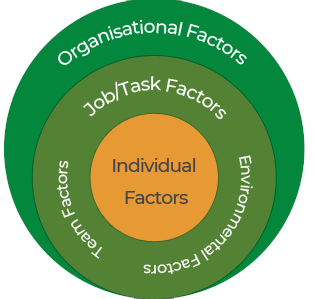The idea of ‘performance influencing factors’ are all those things which can influence how well a task can be done or make an error more likely. The onion model summarises the types of performance influencing factors, and in this article, we’ll focus in on the factors relating to the individual doing the task, right at the centre of the model.
Everyone is unique; we all have differences in our physical size and shape as well as our cognitive abilities (our thinking skills). Some people are good at chess, others are great at crosswords. These kinds of differences can influence how well someone can do a particular job. Equipment should be designed to be used by a wide range of body sizes and shapes, but to do this it often needs to be adjusted by the individual user. The most obvious example is chairs; whether in a train cab or an office, a small person will have to raise the height and pull the chair forward while a taller person will do the opposite. Everyone has different body dimensions, so there is no chair set-up that will work for everyone. Adjusting seats for your own
body makes sure you get the support you need when you are sitting, and this becomes even more important the more of your day you spend sitting. When designing new work environments, like train cabs or signalling centres, human factors pays special attention to designing for the widest possible range of users.
Cognitive abilities also vary, but these are obviously more difficult to design around and for safety critical posts we try to select people who have the right abilities. This is the purpose of the selection tests used for drivers, for example, where we try to match personality characteristics such as conscientiousness and cognitive abilities such as the ability to maintain concentration with the requirements of the job. We also need to make sure that an individual has no underlying health conditions or problems like colour-blindness which might make them unsuitable for a particular role. While these are recognised as important performance influencing factors, human factors doesn’t usually put in place the controls for them. Human resources departments are responsible for selecting the right people for jobs and medical departments are responsible for ensuring medical fitness.
But as well as these fairly stable characteristics of an individual, people can also vary over time. For example, the level of stress in someone’s life (whether personal or professional) varies even on a day- to-day basis. When we’re under stress, we are less able to deal with unexpected situations. Similarly, how tired (or fatigued) someone feels depends very much on how much sleep they’ve had in the last 24 hours. The effects of lack of sleep are well documented, and are often compared to being over the legal drink driving limit in terms of reaction times. Things like stress and fatigue reduce our cognitive processing ability – which is another way of saying they make it harder to pay attention and make good decisions. Often, we rely on our experience to compensate for this reduced ability – we fall back on our habits and routines as a way of reducing the amount of mental effort. In fact, experience at doing a task is another performance shaping factor; the longer someone has been doing the task, the
less effort they have to expend doing it and so the easier it is to manage the task alongside higher levels of stress or fatigue. At the same time, this experience can create error traps where the habits kick in and some difference to the usual situation goes unnoticed. A red signal aspect in a signal that is usually at proceed is a good example of this kind of situation in train driving. Human factors tries to help with these more variable aspects of individual performance shaping factors by designing tasks that reduce the opportunity for error, but also by providing tools and techniques like non-technical skills that help with developing good habits and avoiding ones that could make errors more likely.
Nora Balfe (Irish Rail)

